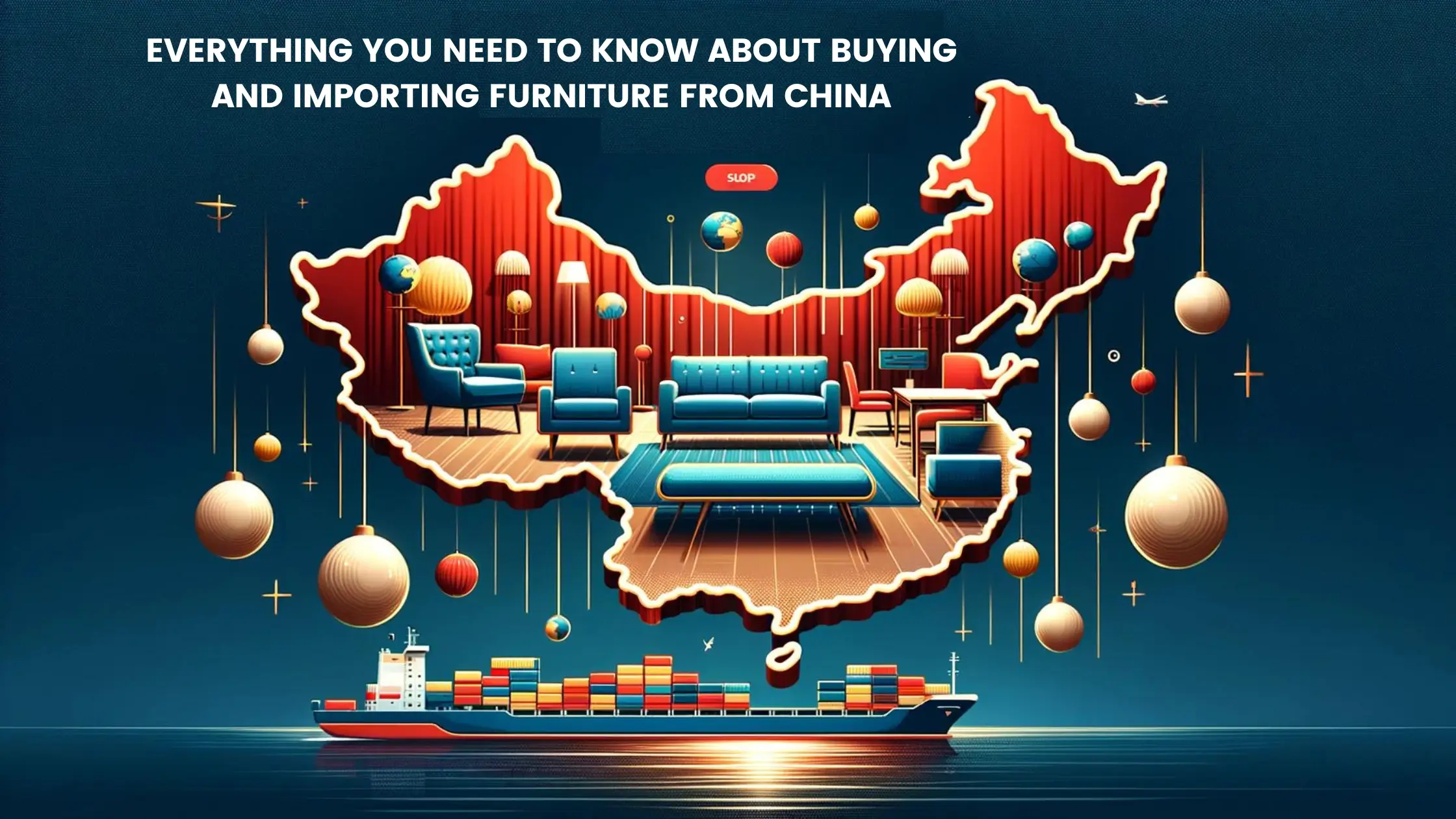Everything You Need to Know About Buying and Importing Furniture from China

Everything You Need to Know About Buying and Importing Furniture From China
Getting into the world of furniture import from China is similar to unlocking a chest packed with diverse styles, excellent value, and cutting-edge designs. This primer is meant to steer both experienced entrepreneurs and passionate enthusiasts through the complex details of the Chinese furniture landscape. Here, innovation meets practice, and scale converges with affordability. China’s extensive manufacturing environment presents an exhibition of quality furnishings that align with diverse preferences and market trends.
Getting engaged with this dynamic market not only widens your products but also sets you strategically in the competitive world of furniture commerce.
Let’s discuss in this blog the information that you need to know about buying and importing furniture from China.
Things to Know Before Buying and Importing Furniture From China
Understanding the Chinese Furniture Market
China’s furniture market is enormous, packed with living and assortment. It’s a great location for anyone aspiring for furniture, with options that range from time-elite handiwork to smart, industrial productions. Not just providing to its extensive domestic market, China’s furniture industry is a giant in the global export arena as well.
Visit for :: furniture sourcing agent
Furniture Varieties at Your Fingertips
China’s furniture selection is rich and varied:
- Residential furniture: Think of any space in your home, and you’ll discover furniture to suit – comfortable sofas, dreamy beds, practical cabinets, and luxury tables.
- Office furniture: Prioritizing work and wellness, this category has modern desks, supportive chairs, and smart storage choices.
- Outdoor furniture: Designed to endure the elements, this category presents stylish patio sets, peaceful garden benches, and stylish poolside furnishings.
- Commercial furniture: Designed for the service sector, these pieces combine layout and function, excellent for hospitality environments.
Setting Up Your Import Objectives
Before you begin on the buying and importing journey from China you must set clear, strategic goals. These will be your compass, steering you through the intricate import maze. Pin down what you’re chasing: a market void, cost advantage, or a splash of novelty?
Defining Your Niche
Identify the unique slice of the market you desire to accommodate. It might be high-end furnishings, green materials, or avant-garde designs. Focusing on your niche lets you import products that echo your clientele’s precise needs, providing you with an advantage and handicraft your brand’s signature.
Knowing Your Audience
The foundation of import success is a profound understanding of your audience. Know their preferences, financial reach, and buying practices. Are they trend-setting youths, homely families, or enterprises? Their priorities and spending limitations will shape your marketing drive and product lineup.
Finding the Right Suppliers
Your company’s lifeline is securing reliable suppliers. Seek out makers who reflect your niche’s beliefs and support your quality standards. Promoting robust connections with your suppliers guarantees transaction efficiency and relentless product superiority.
Researching Suppliers
Before you shake hands with a supplier, do your research. Check their licenses, review product criteria, assess production skills, and check their export savvy. Platforms like Alibaba are a good launchpad, but nothing exceeds direct conversation and, if feasible, a factory visit.
Attending Trade Fairs and Exhibitions
Expos and trade shows are excellent places to meet suppliers. Events like the Canton Fair put the limelight on a variety of products, allowing you to affect and feel the quality. Plus, they’re business goldmines and windows into the newest industry trends.
Visit for :: jewelry sourcing
Verifying Supplier Credentials
Sign contracts only after a particular supplier audit. Solicit recommendations, go over their export ledger, and verify compliance with trade laws. Also, keep an eye out for any specialty badges of recognition, like eco-certificates or quality seals.
Evaluating Quality and Compliance
When importing furniture from China quality and a relentless adherence to global standards, are important for keeping your brand’s reliability and legal compliance.
Understanding Quality Standards
Quality standards function as necessary measures of product safety, perseverance, and overall performance. Within the furniture sector, these standards connect to the selection of materials, the craftsmanship concerned, and the quality of the final touches. Get to understand yourself with protocols like ISO 9001, an expression of vigorous quality management, or ISO 14001, an expression of trustworthy environmental practices. Certifications like these guarantee that the furniture has high-quality standards.
Compliance with International Regulations
Commitment to global regulations is about guaranteeing your furniture imports conform to the complex collection of global trade laws. This has loyalty to safety measures, trade limitations, and ecological regulations. In the world of furniture, this implies compliance with directives such as the RoHS, which limits the use of hazardous implications, or the Lacey Act, which seeks to prevent the illegal trade of timber. Ensuring your furniture imports are within these legal frameworks is imperative to sidestep any legal complications and potential fines.
Navigating Logistics and Shipping
When importing furniture from China, comprehending the logistics and shipping process is important for a successful procedure. This involves choosing the right delivery methods, estimating costs effectively, and selecting appropriate packaging.
Choosing Shipping Methods
Selecting the appropriate shipping process depends on diverse factors, including the size of your order, your budget, and your schedule. The main methods are:
- Sea freight: Perfect for large, heavy loads. It’s cost-efficient for bulk orders but takes longer.
- Air freight: Faster than sea freight but particularly more costly. Appropriate for small, high-value items or urgent freight.
- Rail freight: A middle-ground choice known for certain courses, delivering a balance between cost and speed.
- Courier services: Most appropriate for small packages or pieces. It’s the agile choice but also the most costly.
Calculating Costs and Tariffs
Understanding the full cost of importing includes:
- Freight charges: The price of carrying goods from the vendor to your location.
- Insurance: Protects your shipment against loss or damage.
- Customs duties: Taxes levied on imported goods, which differ by country and product type.
- Value-added tax (VAT): A tax that is applied in many countries, established on the value of the goods.
Use online calculators or consult with a logistics provider to estimate these costs accurately.
Packaging and Container Options
The right packaging is important to safeguard your furniture during transportation. Options include:
- Crates: Solid wood crates are durable and perfect for fragile items.
- Pallets: Useful for storing smaller items and improving handling effectiveness.
- Containers: Shipping containers typically come in 20-foot and 40-foot sizes.
Your goods will be protected by selecting the appropriate container size and shipping costs can be optimized.
Final Take
Getting into the import business with Chinese furniture presents a world of possibility. It’s a journey that requires a strategic procedure, from identifying your specialization to guaranteeing quality and compliance. The key is to understand the market, choose the right suppliers, and handle the logistics with precision. By doing so, you can open the doors to a range of products, satisfy consumer demands, and make a flourishing place in your local market. Remember, thorough research, careful planning, and a focus on quality will be your best allies in this endeavor. Embrace the challenge, and the rewards could be substantial.
READ MORE:: Products to Source from India for Your Brand & Ecommerce Store

